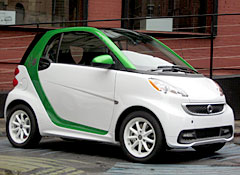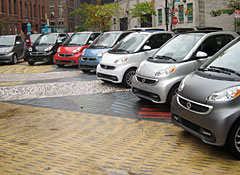The relatively affordable electric Smart ForTwo ED (electric drive) may be the best Smart car yet. While not a high compliment, it does point to the promise of this diminutive two-door model as a green alternative for commuters. We recently drove a production-ready example to check out its smarts.

The Smart was originally conceived, back in the 1980s, as an electric vehicle. But since Daimler thought electrics weren't ready for prime time, it had only offered the Smart with regular gas and diesel engines, as well as limited electric powertrains for fleets. Now it's about to be offered to ordinary U.S. consumers, for sale or lease. It will also be available to fleet and business customers when it goes on sale in the spring. (We drove a prototype back in 2010.)
The heart of the third-generation electric Smart's improvement over the gasoline-version and the previous fleet-only electric is the more powerful 74-peak-hp electric motor and a slightly larger 17.6-kWh lithium-ion battery. Besting the previous 16 kWh pack, the more powerful battery is housed neatly under the floor where the Smart has always had a space for it. The motor's full 74 hp is only available for brief bursts, though, when you floor the accelerator. Top speed is limited to 78 mph; past experience would show you wouldn't want to go faster in the tall, short-wheelbased car. Normally, the power tops out at 47 hp, which we found was adequate for shuttling around Brooklyn at a Mercedes-sponsored drive event this week. (Mercedes-Benz owns Smart.)

Mercedes officials claim the car has a 90-mile range, although they acknowledge its EPA rating is likely to be less than that. Based on that, we estimate a real-world range just short of 70 miles-- a few miles longer than the Mitsubishi iMiev and somewhat short of the Nissan Leaf's range.
When we last tested a gas-powered Smart in 2008, the main selling points of small cars were all absent in the Smart: a low price, great fuel economy, and being fun to drive. Instead, we found the Smart had a harsh ride, clumsy handling, and an automated manual transmission with extremely jerky and jarring shifts. Fuel economy, at 39 mpg, was good, but less than a larger hybrid and it required premium gasoline, undermining potential pump savings.
At the media event, we drove the car in its element, the densest city in America. On the bumpy, grid-configured streets, we didn't really have a chance to test the handling. The familiar stiff, jittery ride, was still there. But the best news was the smooth acceleration. Not only were there no more jerky shifts, there's essentially no transmission at all in this electric model. The power is seamless, and, at least in short bursts, plentiful.
The rest of the car is pure Smart: easy access, two roomy seats, and plenty of equipment. The version we drove, with the built-in navigation system, had next-to-impossible radio controls, with a single knob for volume control that was so tiny it was hard to grasp. Mercedes is offering the car with a full range of designer interiors and custom paint and graphics, including corporate-logo wraps.
Mercedes will also offer the Smart Electric Drive with a choice of three chargers: a simple, $1,300 home unit, a $1,700 unit with an Internet connection for remote monitoring, and a full fleet setup.
Prices will start at $21,750 before the $7,500 federal tax credit, likely making the Smart the cheapest electric on the market when it goes on sale. The company expects fully 30 percent of the 1,000 or so ForTwos sold a month to be electric. That's good, because based on our initial ride, the Smart ForTwo works much better as an electric than as a gas car.





